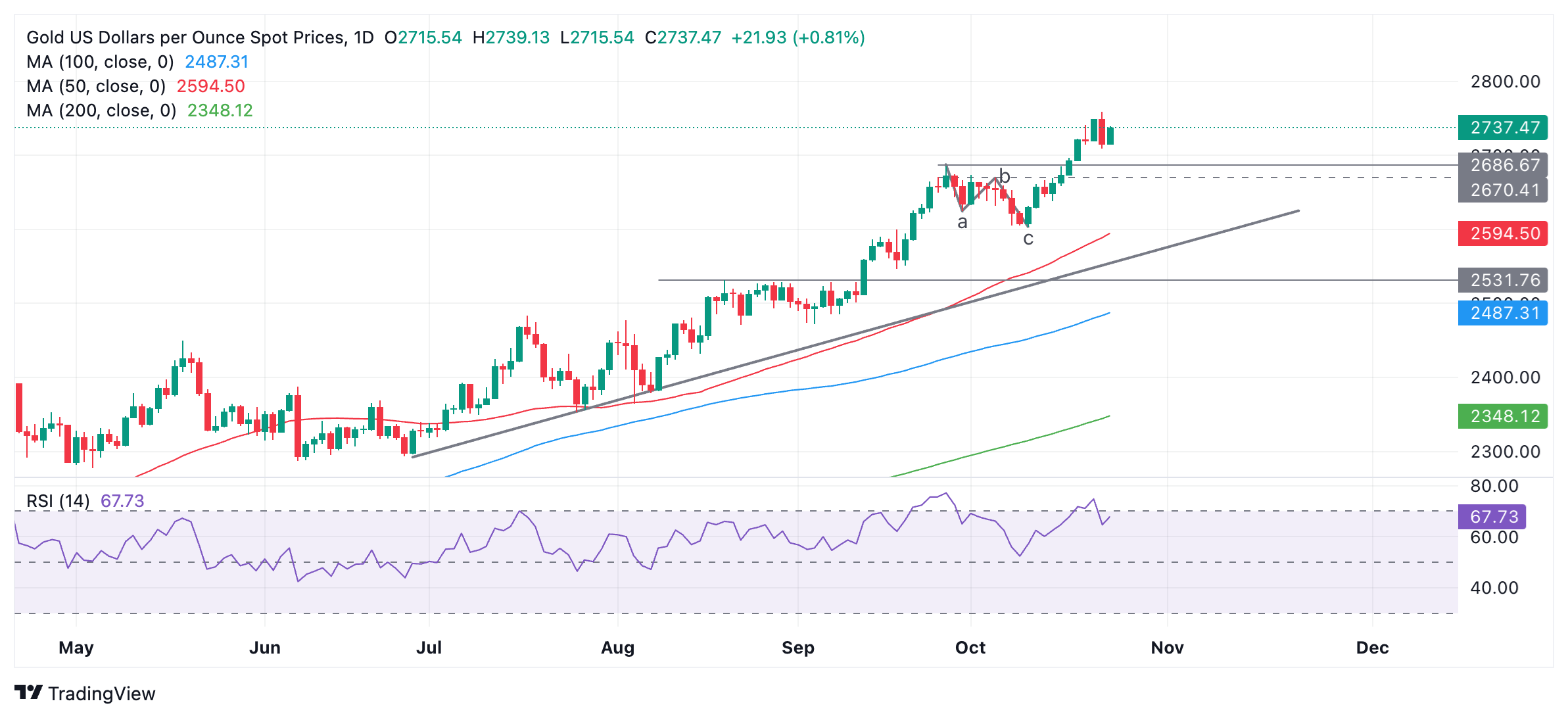Gold rebounds after brief pullback as geopolitical risks rise
- Gold recovers, aided by a rise in geopolitical risks after a steep sell-off on the previous day.
- Speculation that a BRICS Gold-backed currency could become an alternative to the US Dollar also drives flows.
- XAU/USD continues to look bullish as its overall uptrend remains intact and the commodity keeps making higher highs.
Gold (XAU/USD) recovers to trade back in the $2,730s on Thursday, after a 1.2% sell-off on the previous day, most probably driven by profit-taking. The precious metal is once again on the rise on the back of continued safe-haven flows as the conflict in the Middle East continues with no sign of resolution.
Further, the news that North Korea has sent troops to Russia to potentially participate in the war with Ukraine has ratcheted up geopolitical risks, as has increased election uncertainty in the US.
Gold recovers as major central banks slash interest rates
Gold sees further upside as a result of the Bank of Canada’s (BoC) decision to slash its cash rate by 50 basis points (bps) on Wednesday and increasing speculation the European Central Bank (ECB) might do the same in December, after the release of tepid economic data for the region. With interest rates set to fall rapidly all over the globe, Gold should benefit given this will increase its attractiveness as a non-interest-paying asset.
That said, in the US market expectations of the trajectory for interest rates have been subject to a substantial revision after the release of robust labor market data reduced the chances of the US Federal Reserve (Fed) aggressively cutting US interest rates.
A further factor helping Gold price higher could be the focus on the BRICS 2024 summit in Kazan, Russia, as members – especially Russia – seek to find an alternative to the dominance of the US Dollar (USD), with a currency backed by Gold touted as a viable alternative.
Technical Analysis: Gold pulls back then rebounds
Gold pulled back over 1.2% on Wednesday but rebounds on Thursday, continuing its rally higher.
The yellow metal is in a steady uptrend on all time frames (short, medium and long) which given the technical dictum “the trend is your friend” favors more upside. Having breached $2,750, the next big-figure target level lies at $3,000 (round number and psychological level).
XAU/USD Daily Chart
The Relative Strength Index (RSI) has pulled back out of overbought, advising long-holders to close their long positions and open shorts. It is possible this could herald a deeper correction, however, given the strong uptrend it is not enough alone to be certain. Support lies at $2,750, $2,700 (key round-number levels) and $2,685 (September high).
Gold’s overall strong uptrend, however, suggests that any corrections will probably be short-lived, and afterward, the broader bull trend will resume.
Gold FAQs
Gold has played a key role in human’s history as it has been widely used as a store of value and medium of exchange. Currently, apart from its shine and usage for jewelry, the precious metal is widely seen as a safe-haven asset, meaning that it is considered a good investment during turbulent times. Gold is also widely seen as a hedge against inflation and against depreciating currencies as it doesn’t rely on any specific issuer or government.
Central banks are the biggest Gold holders. In their aim to support their currencies in turbulent times, central banks tend to diversify their reserves and buy Gold to improve the perceived strength of the economy and the currency. High Gold reserves can be a source of trust for a country’s solvency. Central banks added 1,136 tonnes of Gold worth around $70 billion to their reserves in 2022, according to data from the World Gold Council. This is the highest yearly purchase since records began. Central banks from emerging economies such as China, India and Turkey are quickly increasing their Gold reserves.
Gold has an inverse correlation with the US Dollar and US Treasuries, which are both major reserve and safe-haven assets. When the Dollar depreciates, Gold tends to rise, enabling investors and central banks to diversify their assets in turbulent times. Gold is also inversely correlated with risk assets. A rally in the stock market tends to weaken Gold price, while sell-offs in riskier markets tend to favor the precious metal.
The price can move due to a wide range of factors. Geopolitical instability or fears of a deep recession can quickly make Gold price escalate due to its safe-haven status. As a yield-less asset, Gold tends to rise with lower interest rates, while higher cost of money usually weighs down on the yellow metal. Still, most moves depend on how the US Dollar (USD) behaves as the asset is priced in dollars (XAU/USD). A strong Dollar tends to keep the price of Gold controlled, whereas a weaker Dollar is likely to push Gold prices up.

